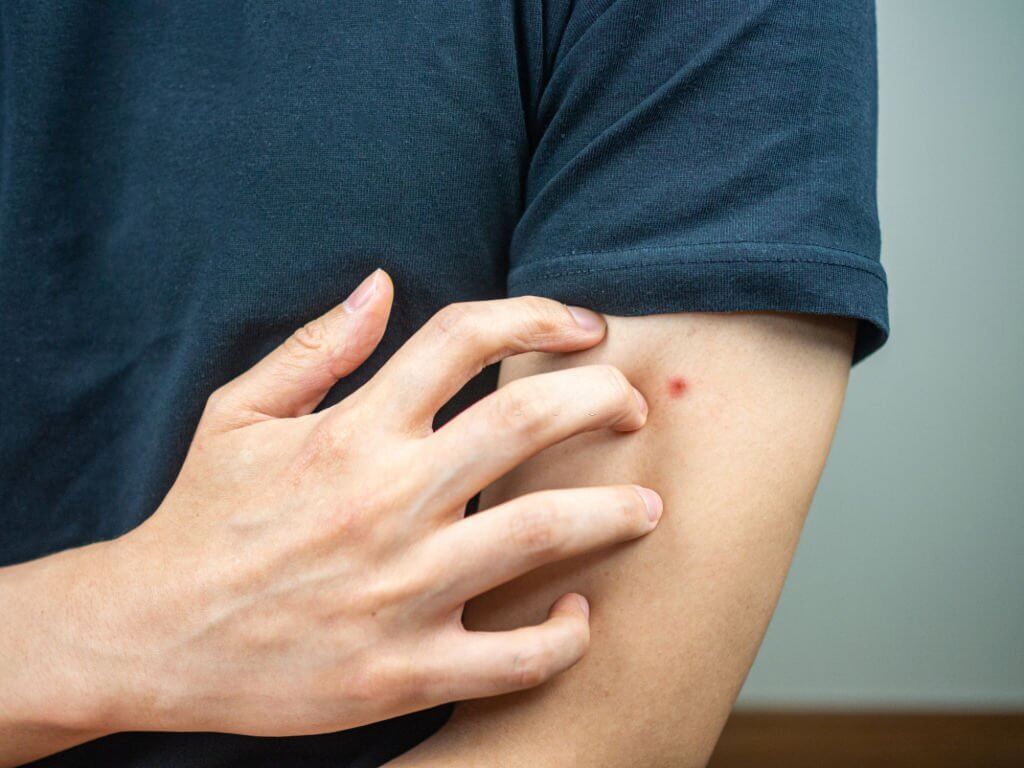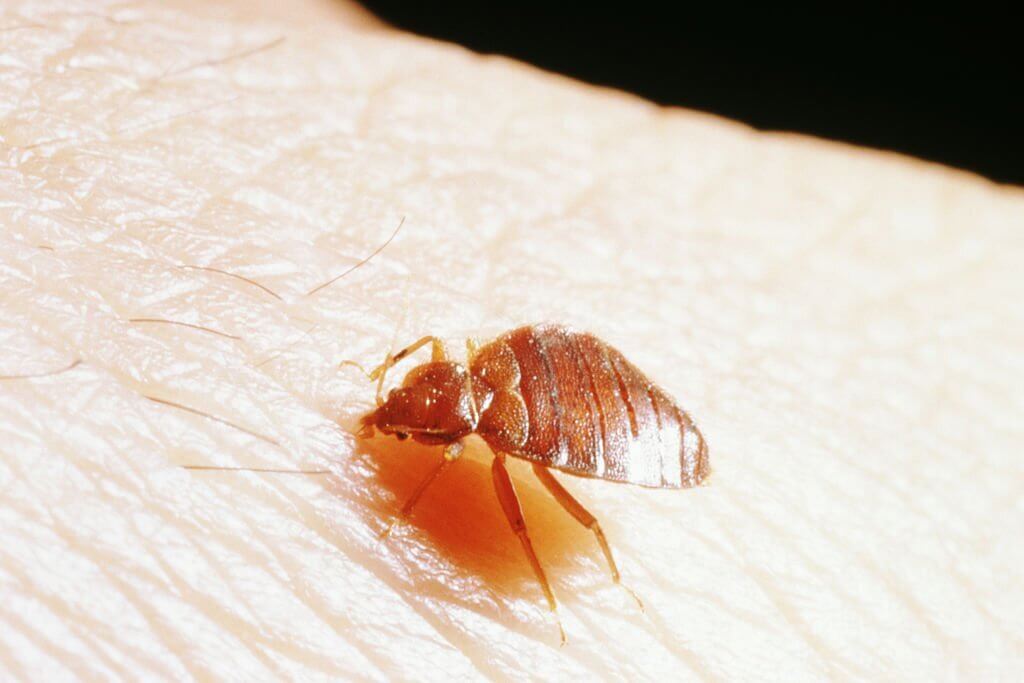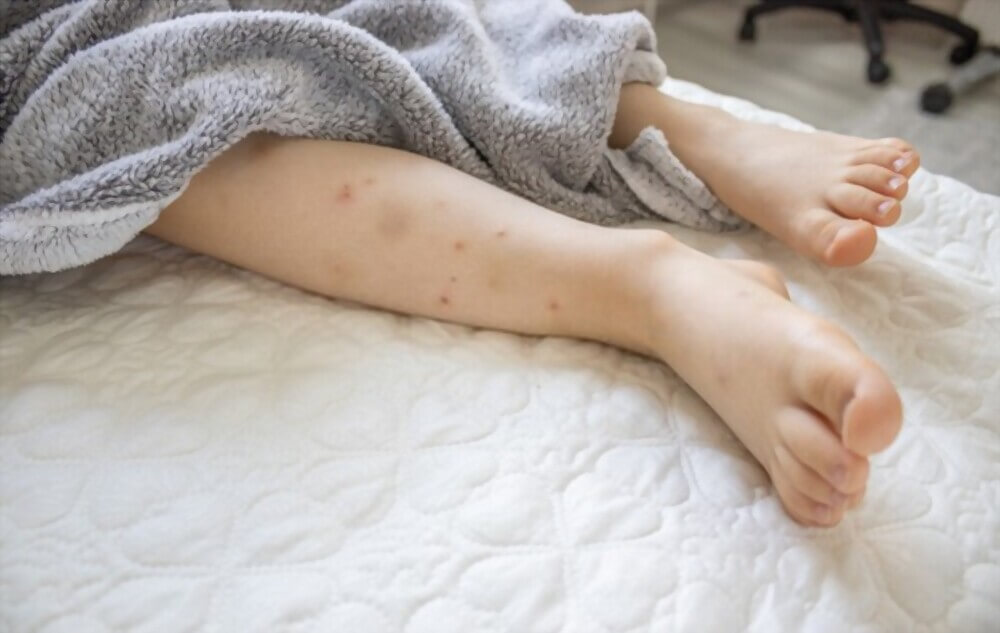The presence of bed bugs can certainly keep us up at night – literally. Their bites are itchy and painful while posing the risk of disease and discomfort. Whether you’re staying in a hotel or just trying to enjoy a restful sleep in your own home, learning how to prevent bed bug bites is key.
This article will provide helpful information on identifying signs of an infestation, preventive measures, treating existing bites, and tips for avoiding future encounters with these pesky parasites.
Don’t let this little issue ruin your nights; read on to learn more about preventing bedbugs from joining you in the land of sweet dreams!
Understanding Bed Bugs and Their Bites
Bed bugs are small, reddish-brown insects that feed on human blood, leaving itchy bites and can survive in lint, clothes or furniture upholstery.
Description and appearance of bed bugs
Bed bugs are small, wingless insects that measure about 1/5 inch in length. They have a flattened oval shape and copper-brown coloration. Some bed bugs may appear to be almost gunmetal black or even red after they have fed on blood.
Though the adult specimens don’t possess wings, their legs are long enough for them to move quickly across surfaces and climb up walls. While bed bugs can survive without food for two months or more, most become inactive when deprived of a meal for longer than one week.
Careful inspection is essential in recognizing these parasitic pests as their color allows them to blend into their surroundings with ease; typically hiding inside cracks and crevices near beds where they feed during nighttime hours.
Signs of a bed bug infestation
- Bite marks on the face, neck, arms, hands, or other body parts that occur while sleeping
- Presence of bed bug eggs or shells
- Dark spots on bedding or furniture
- Musty odor produced by the insects themselves
- Live bed bugs near seams of mattresses or in cracks and crevices around the bedroom
Early detection of a bed bug infestation is critical as unchecked populations can cause greater property damage and health risks. Unchecked populations can migrate to adjacent rooms or dwellings and make a home infestation even more serious. If you think you have a bed bug infestation, it’s important to not ignore it – contact professionals who are familiar with bed bug control so further damage is avoided.
Characteristics of bed bug bites
Bed bug bites are clusters of three to five-pin-sized red marks appearing in a zigzag pattern that can often be mistaken for other insect bites. Usually painless, the bites themselves may go unnoticed but can cause extreme itching due to an allergic reaction or sensitivities in some individuals.
The bugs will typically feed on exposed skin like the face, neck and arms during sleep. Bed bug bite symptoms include redness and swelling around the bite site with hives or blisters possibly developing for those with allergies or sensitivities.
Accompanying signs of infestation include droppings, egg casings, and a musty odor near where you spend most of your time sleeping – so take precautions by keeping your sleeping area free from clutter and regularly washing bed linens at high temperatures.
Preventive Measures to Avoid Bed Bug Bites

Maintaining cleanliness in sleeping areas, washing bedding at high temperatures, and regularly inspecting mattresses are key to preventing bed bug bites.
Keeping your sleeping area clean
Maintaining a clean and hygienic sleeping area is essential in preventing bed bug bites. Bed bugs are attracted to sources of warmth, blood, and carbon dioxide, so they’ll flock to beds that are not regularly cleaned or properly maintained.
To reduce the number of bed bugs that can attack you while sleeping, it’s important to vacuum your mattress often, wash sheets in hot water frequently, and use mattress covers when possible.
Doing these things will help eliminate infestations from developing and reduce your chances of getting bitten by bedbugs while you sleep. Moreover, using insecticide sprays or traps along with regular cleaning can further reduce the chance of bedbug infestations occurring around your home.
Washing bedding in high temperatures
Keeping your sleeping area clean and sanitized is a very important step when trying to prevent bed bug infestations. Washing in hot water and/or drying on high heat can help to kill any existing bed bugs, as well as reduce the risk of future infestation.
High temperatures from washing machines, dryers, or direct sunlight are effective at killing off bed bugs because they cannot withstand intense heat for extended periods of time. Bedspreads, sheets, blankets, and clothes that touch the floor should be washed regularly in hot water or heated up by having two cycles in the dryer on a high heat setting; this will ensure all adult pests have been eliminated.
As an added precaution it may also be beneficial to invest in exterior protective layers like mattress encasements that create a barrier between you and potential pests while protecting contents inside from damage due to their impermeable material construction.
Regularly vacuuming and inspecting your mattress
is an important part of preventing bed bug bites while sleeping. Vacuuming greatly reduces the number of bugs in your home and can help identify where bed bugs may be hiding. Spot-cleaning daily by vacuuming all areas around beds, furniture, floorboards, baseboards, and cracks in walls or flooring can help prevent a bed bug infestation from spreading. Inspecting mattresses for stains or droppings that could indicate the presence of bed bugs is another effective preventive measure.
Treating and Eliminating Bed Bugs
Eliminating bed bugs requires professional help or DIY using insecticides, heat treatment and other treatments which can be explored in the article to ensure your safety.
Seeking professional help for infestations

If a bed bug infestation is suspected, it is important to seek professional help as soon as possible. Professional exterminators can provide targeted and effective treatments they are trained.
Not only do their services inspect the living area thoroughly, but also offer methods of eliminating and controlling the infestation in the long run by frequently inspecting, and treating surfaces with insecticides or other chemical solutions if needed.
Additionally, pest control professionals possess knowledge about different types of bugs and use specialized equipment such as microscope slides in order to properly identify pests that have invaded the space accurately.
This expertise helps make sure that whilst eradicating an infestation one doesn’t end up creating another problem by incorrectly targeting pesticides at harmless creatures like ladybugs or beetles mistakenly identifying them as bed bugs.
Using insecticides and other treatments
When it comes to fending off and eliminating bed bugs, there are various methods that can be employed. This includes using insecticides, biochemicals, vacuuming and more.
- Insecticides such as permethrin, cyfluthrin or diethyltoluamide (DEET) are effective at treating bed bug problems. These can be applied as liquids, aerosols or dusts into cracks and crevices around beds where bed bugs may hide.
- Neem oil is a natural pesticide derived from neem trees that have also been found to have pesticidal properties against bed bugs when cold-pressed and refined appropriately. It is typically available in liquid form and can be sprayed or brushed on walls and furniture lightly to repel the bugs.
- Vacuuming is an effective method of eliminating bed bugs in small areas, though it should always be followed up with appropriate treatments afterward depending on the severity of the infestation. Vacuuming regularly—at least once weekly—can help eliminate small numbers of bed bugs before they have a chance to spread too far through a home or facility.
- Professional pest management services can also be hired for more severe infestations where heavy applcations of insecticides are necessary for complete elimination of an infestation.
Dealing with Bed Bug Bites
Use over-the-counter remedies like antiitch products, antihistamines, and noodor sealant to manage bed bug bite symptoms and find out the other treatment methods available. Find out more in this article!
Treating bed bug bites with over-the-counter remedies
There are many over-the-counter remedies that individuals can use to treat bed bug bites. These remedies will provide relief from itching, skin irritation, sores, and other symptoms associated with bed bug bites. It’s important to keep in mind that the severity of the bite and potential allergies or reactions should be taken into account when selecting an appropriate remedy:
- Anti-Itch Creams: Products such as calamine lotion have antihistamines which work to reduce inflammation and relieve itchiness caused by bed bug bites. Before application, it is recommended that you test a small amount on your arm or leg prior to applying more extensive amounts over a large area of skin affected by the bite.
- Hydrocortisone Skin Creams: Hydrocortisone creams also contains antiinflammatories which target areas irritated by bed bugs cutting down on bothersome irritation caused by scratching at inflamed areas of skin due to unbearable itching.
- Oral Antihistamines: Although oral medications like Benadryl may not be powerful enough for some severe cases, they can still help ease mild annoyances of irritatingly itchy skin due to infestations where topical treatments fail in providing adequate relief . Be sure every individual using this treatment has consulted their healthcare provider before taking any form of medication including oral antigetamines as these pharmaceutical agents come with certain warnings and side effects depending upon the person’s age , weight, medical history , etc.,
- Topical Treatments: Topical treatments such as aloe vera gel contain curative powers which helps inhibit swelling while healing up acnes associated with bedbug infestations
- Soothing creams: Chamomile cream not only relieves painful burning sensations from insect stings but is equally effective for treating minor cuts too
- Antipyretic Medications: As part of common practice especially amongst older adults Tylenol/ Advil are likely apt choices for preventing fever linked complications resulting form insect bites provided due precautions have been taken beforehand pertaining any pre existing health conditions etcof those thinking about using this type pf solution
Recognizing signs of an allergic reaction
While bed bug bites can be common and their effects are usually no more than an inconvenience, for some individuals they may lead to a severe allergic reaction. Common reactions include severe itching, blisters or hives, though it is also possible that the bites could be mistaken for other skin conditions such as an itchy rash or chickenpox.
True allergic reactions to bed bug bites are rare, with the most serious being anaphylactic shock and this should not cause too much concern for those who are infiltrated by these pests.
It’s important that individuals recognize signs of a potential allergic response so they can take steps towards treatment if necessary; however, it is equally important for people to keep in mind how uncommon true allergies due to bed bug bites truly are.

